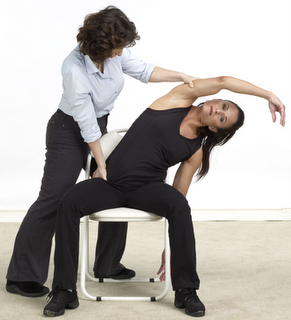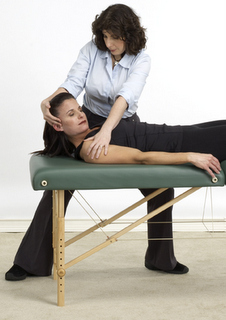To Stretch or Not to Stretch? This should not even be a question.
[updated august 2020]
Should you stretch or shouldn’t you stretch? Is stretching good for you or is stretching bad for you?
The fact is, stretching is something that we do naturally. The question you really should be asking is “how should you consciously stretch?”
The first step in healing, exercise, and life is awareness. People tend to be disconnected from their bodies. They know they are in pain, tired or just not “as young as they used to be.” There is that feeling of something is not right or “off” with their body and they see the choice is either doctor visits and pills, or worse acceptance and coping. The truth is that these feelings are calls for help from the body and that is not getting through. For healing to begin the connection between mind and body needs to be reestablished.
What is Integrated Therapeutic Stretching ™
Integrated Therapeutic Stretching™ (or I.T.S) is an extremely effective stretching therapy that works with the body to figure out and correct what’s gone awry. The objective of ITS™ is to aid and empower the client with the tools to re-educate and maintain a balanced physiological and emotional system.
Whether you are rehabbing, training or just going through daily routines of life the body needs balance, it needs to be both flexible and strong. Unfortunately, in both rehab and life flexibility tends to be an afterthought, or it is the last step when it should be the first. One should never strength train a joint that does not have full ROM. If a muscle and surrounding fascia are restricted strength training can cause more of a restriction and possible damage to occur. On the flip side, one should never open up a restricted/adhered joint/muscle without understanding the reasons why it is tight. Is it compensating? If so why? Is there an injury? A disorder? Simply releasing a tightly restricted area without this knowledge can lead to the body’s stability being compromised.
Benefits of Integrated Therapeutic Stretching ™
 Integrated Therapeutic Stretching™ is a system designed to help an individual achieve and maintain balance and well-being. It’s not strain/counter-strain, PNF (proprioceptive neuromuscular facilitation), or any of the other popular systems claiming increased flexibility and function by simply exhausting muscle fibers into laxity. Integrated Therapeutic Stretching™ teaches the individual how to stretch each muscle and the surrounding fascia distinctly (in non-loading positions), releasing the connective tissue while re-training each muscle to perform correctly, individually and cohesively within its muscle group.
Integrated Therapeutic Stretching™ is a system designed to help an individual achieve and maintain balance and well-being. It’s not strain/counter-strain, PNF (proprioceptive neuromuscular facilitation), or any of the other popular systems claiming increased flexibility and function by simply exhausting muscle fibers into laxity. Integrated Therapeutic Stretching™ teaches the individual how to stretch each muscle and the surrounding fascia distinctly (in non-loading positions), releasing the connective tissue while re-training each muscle to perform correctly, individually and cohesively within its muscle group.
Let’s face it; we all have times when our daily actions are less than beneficial for our health & wellbeing, whether due to trauma, exhaustion, improper training, or boredom. When that imbalance exists, our muscles learn to function incorrectly or to compensate. Without corrective stimulus, the compensation cycle continues to force the muscles into working inaccurately and inefficiently. We all need a simple and effective practice that helps our body to return to maximum performance, efficiency and wellness.
Another hindrance to balance and recovery is that what a person perceives as normal posture and movement is usually a skewed perception. When in pain or injured the body compensates in order to function. If these compensations are not corrected then the compensation pattern is eventually perceived as the normal state of being by the brain. Since the body needs to continue to function, a person’s perception of straight is altered to believe the chronic restriction/misalignment is the norm and the norm is incorrect.
How many times have you straightened out a client who is laying crooked on your table only to have them say “Well now I feel crooked”? If we do not make our clients aware of how they are improperly moving then we will never truly be able to restore them to balance. The average person has no idea how to get out of bed, up out of a chair or how to bend over and pick up their keys. When you combine this with the body’s predilection for compensation the end result is pain and injury. I am not impressed by the perfect kettlebell swing if that same person cannot stand up straight and walk across the room without strain.
Therapists are just as guilty of these misperceptions. They tend to use muscle when they work instead of proper body mechanics which allows them to move with less effort, more efficiency. To become an extension of their clients rather than working on them.
When I teach the ITS™, I literally find myself wrapping around the practitioner in order to retrain them on how to move. They have no clue that they are moving in cross forces from the client causing the client’s body to react, fighting against, instead of releasing with them. If the practitioner is unaware of what proper body mechanics are and that they themselves are incorrectly using their bodies, then how can they properly assist their clients on their journey back to health? For this reason alone, I decided to make the Integrated Therapeutic Stretching™ courses a pre-requisite for the advanced S.T.R.A.I.T Method™ Scar courses. Not only does it open the practitioner’s eyes to the importance of proprioception and body mechanics for themselves, but it also gives them the tools to educated and rehabs their clients once the tension of the scar tissue is released.
Once the connection between mind and body is reestablished through awareness the next step is empowerment.
 Through specific focused active stretching and strengthening, ITS™ helps re-educate the body on how to move the way it was designed, leading to increased joint range of motion (ROM), lymphatic and venous circulation. The emphasis is placed on building and maintaining muscular flexibility, strength, and endurance throughout the body. Since it is an active modality the client is given the power to aid in their own recovery. For some, it gives them back control over their bodies.
Through specific focused active stretching and strengthening, ITS™ helps re-educate the body on how to move the way it was designed, leading to increased joint range of motion (ROM), lymphatic and venous circulation. The emphasis is placed on building and maintaining muscular flexibility, strength, and endurance throughout the body. Since it is an active modality the client is given the power to aid in their own recovery. For some, it gives them back control over their bodies.
Massage/Physical therapists are expected to alleviate stress, help with relaxation, and relieve pain caused by injuries, repetitive use, and physical limitations. A therapist’s success in doing so often leads clients to view their therapist as a “cure-all.” Sooner or later, however, a therapist might be faced with questions from their clients such as: “Why does the pain keep coming back?” or “I feel better, but I am afraid to do anything that might start the pain again.”
If you would like to empower your clients to take an active part in their own health, consider incorporating Integrated Therapeutic Stretching™ into your practice.
How I.T.S™ Works
There are two primary principles that provide the basis for how ITS™ works.
The first is the mechanism of reciprocal inhibition and innervations working together. If you want to lift your arm, your nervous system has to shut off the muscles that bring your arm down (inhibition) while turning on the ones that lift it up (innervations). ITS™ works with your nervous system and in the process re-educate the muscles on how to function properly and how to utilize and maintain full ROM.
The second principle is to hold the stretch for 2 seconds. Holding a stretch for longer than 2.5 to 3 seconds triggers a protective stretch reflex in the muscle fibers, and the muscle you are trying to stretch contracts. By not tripping the stretch reflex, you are able to get a gentle stretch without having the bodywork against itself. The stretch is repeated multiple times in a set(s). The repeated “pumping” action of the muscle allows for increased circulation to the area. By targeting very specific angles of the muscle and promoting full ROM of the joint, the results are a highly efficient and effective stretch, affecting the muscles from origin to insertion. It reaches areas a therapist’s fingers and hands cannot go. With ITS™, you can address injuries such as sprained ankles and pulled muscles as well as physical issues/disorders such as sciatica, multiple sclerosis, scleroderma, scoliosis, and paralysis. Most importantly, you give your clients the ability to fend off the multitude of physiological and psychological effects their disease or reoccurring injury is causing.
Client Success Stories
I have used ITS™ with success for clients ranging from children to seniors and presenting a broad range of problems. Below are the stories of two clients who experienced dramatic results with ITS™.
Client Story 1: “Tom,” 49, suffers from multiple sclerosis (MS). When physical therapy and pain management no longer yielded results, his insurance company stopped coverage, leaving him house-bound without any means of therapy or aid. As a former college athlete, Tom was utterly frustrated at his loss of control over his own body.
When I met Tom, he was 60lbs overweight, wheelchair-bound and depressed. I explained how ITS™ works and that I needed his help if the therapy was going to be successful. He looked doubtful but said he would do whatever he could. Since Tom was starting to experience drop foot and his ankles were very swollen, I started there. After showing Tom how to use the stretching strap to assist himself, I asked him to concentrate on lifting up his foot and giving a light pull on the strap at the end of the movie. While we worked together, his edema went down, and Tom started to get excited. The motor functionality in his feet started to improve, and Tom’s enthusiasm increased. As we progressed on to other areas of his body, I explained how he could perform the stretch on his own, and I also showed his wife how she could assist him. After two sessions, Tom insisted on coming to my office instead of having house calls. After six visits, Tom amazed and thrilled me by coming up the walkway to my office using his walker. His wife informed me with a big smile that he had been doing his exercises every day and his whole attitude had changed. Today, Tom has lost 40lbs, goes out with friends again and seems to have a new lease on life. He still has bad days and setbacks because of the MS, but with the help of ITS™, he has the ability to slow down its progression and take some control back over his life.
Client Story 2: “Brad,” 13, has pectus excavatum (also known as sunken or funnel chest). Brad’s mother is a scar tissue release therapy client who sought relief from her c-section restriction and lower back pain. She asked if I thought I could do something for her son’s fingers, which had been broken two years prior and had not healed properly. As soon as I met Brad, I knew that his fingers were the least of his problems. Despite standing slouched forward, typical of many 13-year-old boys, I could clearly see that his right shoulder was internally rotated and basically stuck to his chest. The left side was rounded forward in compensation with the right. His arms were rotated outward, giving him the appearance of normal function. His head also jutted forward. As far as his fingers were concerned, the phalanges of the two middle fingers were truly sticking out. The fingers had never received any rehabilitation. After a few stretches, I showed Brad specific ITS™ stretching exercises and gave him a hand-exercise ball to take home.
Once his fingers were taken care of, I asked his mother to explain what was going on with his shoulder. Apparently, Brad had broken his collarbone coming through the birth canal. He was put in a sling and that was it. Over the years, she had asked the doctors if there was a problem with the way Brad’s shoulder was developing and the reply was always the same: “No that is just the way he is growing.” With her and Brad’s permission, I started to work on his shoulder. I gently went through the protocols for the shoulder and neck while explaining to him what I was doing and why. I made sure that he was actively involved in every aspect of the session. Within 20 minutes, Brad’s shoulder was no longer pressed against his chest and was already gravitating to its proper functional position. I gave him a homework assignment of stretch and strength exercises and went to work on his mom. While I was working on her, I could see Brad moving his shoulders around. When I asked him how they felt, he replied: “Weird, but in a good way.”
On Brad’s second visit, he told me that baseball practice was awkward at first because he kept overthrowing the ball until he got used to the way his shoulder was moving. On his third visit, he told me that his endurance was better. I asked him if he was able to take deeper breaths and get more oxygen into his lungs, and he said yes. His mother was happy that she no longer had to tell Brad to stand up straight. On his fourth visit, his mother told me with tears in her eyes how Brad was doing so well in basketball now that the other night he and his father would not come in out of the rain; they just kept shooting basket after basket. Brad continues to come once a week for stretching and strength training. All of his atrophied/undeveloped muscles are coming back to life, and he is learning how to use his body more effectively. Recently, he asked if we could start stretching his legs since the soccer season was starting up.
Incorporating ITS™ in Your Practice
It is always a challenge to introduce any new technique to your clients. People usually prefer the security of your established routine and are wary of anything new. It is slightly more so with ITS™ since it requires the patient to be an active participant. If a client is hesitant, you can start by introducing small sets of stretching at the beginning of the session before you start to massage. The cervical and wrist stretches can be performed with the client already undressed and on the table. You can also offer to stretch an area of injury or discomfort, like sciatica, before the client gets undressed as a free demonstration. Eventually, you can offer a half-and-half session where the client can be stretched first and then receive a massage. Once your clients experience the results of the stretching, they will be more inclined to book whole stretching sessions.
ITS™ is a simple and effective technique that helps to enhance performance, decrease the likelihood of injury and reduce muscle soreness. It helps to increase blood supply and lymphatic flow and the delivery of nutrients on a cellular level. ITS™ improves ROM of the joints and aids in neuromuscular re-education. Used therapeutically, ITS™ works with the body, not against it, and empowers clients to take an active role in their own well-being. Furthermore, it works hand-in-hand with scar tissue release, massage, and other bodywork techniques. Inspiring your clients to be active participants in their own healing process and maintaining their health is the most powerful effect of all.
》A B O U T M A R J O R I E B R O O K 
Marjorie Brook, LMT is a massage therapist, author and international educator with a private practice located on Long Island, NY. She works from the fundamental belief that your body is intuitively aligned with the thoughts you think, the emotions that you feel and the things that you do. She founded Brooks Seminars in 2007 after working as a decade as a nationally recognized massage therapist with a private practice on Long Island. She is the creator of the Scar Tissue Release and Integrated Therapies (S.T.R.A.I.T Method™) and offers continuing education courses on this method all over the world. Her articles have appeared in magazines such as Massage Today, American Fitness and Massage World. She’s approved by the National Certification Board for Therapeutic Massage and Bodywork, the Massage Therapy Association of Alberta and the College of Massage Therapists of British Columbia.
